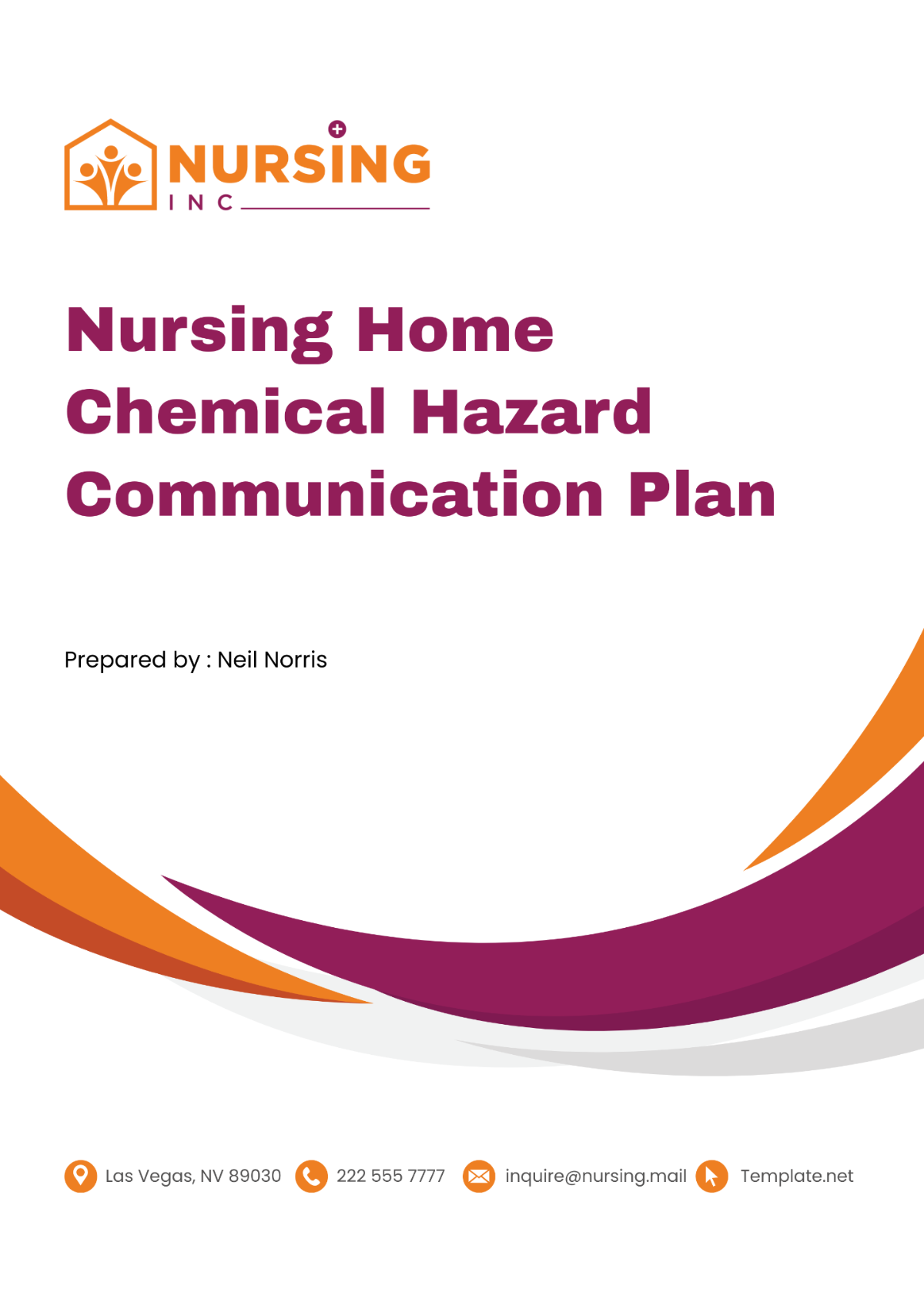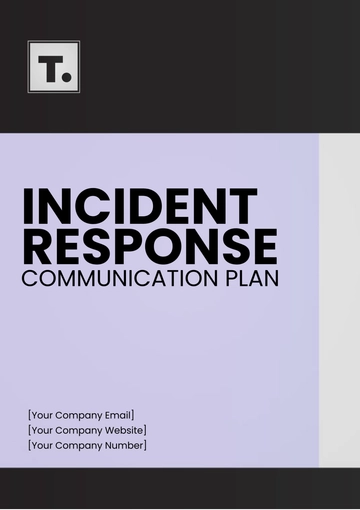Free Nursing Home Chemical Hazard Communication Plan

Introduction
At [Your Company Name], we recognize the inherent risks associated with the use of chemicals in a nursing home environment. With a diverse population that includes vulnerable residents, the careful management of these substances is critical to ensuring a safe and healthy living space. The Nursing Home Chemical Hazard Communication Plan is designed to establish a comprehensive approach to the handling, storage, and disposal of chemicals. This document serves as a blueprint for preventing accidents and mitigating risks associated with chemical exposure, ensuring the well-being of our employees, residents, and visitors.
I. Objective
The primary objective of this plan is to foster a safe environment within [Your Company Name] by managing chemical hazards effectively. To achieve this, we aim to:
Identify and assess the risks associated with chemical use within our facilities.
Develop and implement protocols for the safe handling and storage of chemicals.
Provide comprehensive training for all employees on chemical safety, including the correct use of personal protective equipment (PPE) and emergency procedures.
Enhance awareness among residents and visitors regarding the potential risks and the measures in place to protect their safety.
Formulate and refine emergency action plans to respond efficiently to chemical accidents or incidents.
This objective underscores our commitment to not only comply with but exceed local, state, and federal regulations concerning chemical safety. Our goal is to create a culture of safety that permeates every level of our organization, ensuring that every member of our community feels informed, protected, and valued.
II. Chemical Inventory
A crucial step in mitigating chemical hazards is maintaining an accurate and comprehensive inventory of all chemicals present on our premises. This inventory acts as the foundation for our risk assessment, safe handling protocols, and training programs. Below is a table that summarizes our current chemical inventory, highlighting the quantity and storage location of each substance:
Chemical Name | Quantity | Storage Location |
|---|---|---|
Bleach | 20 Liters | Laundry Room |
Isopropyl Alcohol | 10 Liters | Medical Supplies Room |
Disinfectant Spray | 15 Liters | Cleaning Supplies Storage |
Surgical Spirit | 5 Liters | First Aid Room |
Hydrogen Peroxide | 8 Liters | Medical Supplies Room |
This inventory is regularly updated to reflect any changes in the types or quantities of chemicals on site. By maintaining this inventory, we ensure that all staff members have access to current information, facilitating better risk management and emergency preparedness.
III. Risk Assessment
We understand the critical importance of conducting thorough risk assessments for all chemicals used within our facilities. These assessments are conducted to identify and evaluate potential hazards associated with each chemical, ranging from the risk of explosions to toxicity levels. By systematically assessing these risks, we can implement appropriate safety measures and protocols to mitigate potential dangers effectively.
Our risk assessment process begins with a comprehensive review of each chemical's properties, intended use, and potential hazards. This includes examining factors such as flammability, reactivity, corrosiveness, and toxicity. Utilizing industry-standard risk assessment methodologies, we assign a risk rating to each chemical based on the severity of its potential hazards.
The risk ratings inform the development of specific standards and procedures tailored to each chemical's unique risks. For chemicals deemed high-risk, stringent safety protocols are established to minimize the likelihood of accidents or incidents. This may include implementing additional containment measures, restricting access, or requiring specialized training for handling and storage.
Additionally, our risk assessment process considers the potential for chemical interactions and the cumulative effects of multiple substances within our environment. By taking a holistic approach to risk assessment, we can identify potential synergistic effects or unforeseen hazards that may arise from the interaction of different chemicals.
Regular reviews and updates to our risk assessment protocols ensure that we remain proactive in addressing emerging risks and evolving regulatory requirements. By staying abreast of advancements in chemical safety practices and technology, we can continually refine our risk assessment processes to enhance the overall safety of our facilities.
IV. Safe Handling and Storage Procedures
Establishing clear and comprehensive protocols for the safe handling and storage of chemicals is paramount to preventing accidents and ensuring the well-being of our staff and residents. At [Your Company Name], we prioritize safety in every aspect of our operations, and our handling and storage procedures reflect this commitment.
Our handling procedures outline best practices for safely transporting, transferring, and using chemicals within our facilities. This includes guidelines for proper personal protective equipment (PPE) usage, such as gloves, goggles, and protective clothing, to minimize the risk of exposure to hazardous substances. Additionally, we emphasize the importance of proper ventilation and containment measures to prevent accidental releases or spills.
When it comes to storage, we adhere to strict guidelines to minimize the risk of chemical incidents. Chemicals are stored in designated areas that are appropriately ventilated, well-lit, and equipped with spill containment measures. Flammable substances are stored separately from oxidizing agents, and incompatible chemicals are segregated to prevent potential reactions.
Regular inspections and maintenance of storage facilities ensure compliance with regulatory requirements and identify any potential hazards or deficiencies. Spill response kits and emergency equipment are readily available in key locations to facilitate swift and effective response in the event of an incident.
V. Training and Education
We recognize that knowledge is the foundation of safety. That's why we prioritize comprehensive training and education for all employees regarding the safe handling, storing, and disposal of chemicals. Our training programs are designed to equip staff with the knowledge and skills necessary to identify potential hazards, mitigate risks, and respond effectively to emergencies.
Training sessions cover a wide range of topics, including chemical hazards, proper handling techniques, emergency procedures, and the use of personal protective equipment (PPE). Through interactive training modules, hands-on demonstrations, and real-world scenarios, employees gain practical experience and confidence in their ability to safely work with chemicals.
Regular refresher courses and updates ensure that staff remain up-to-date on the latest safety protocols and regulatory requirements. Additionally, new employees receive comprehensive onboarding training to familiarize them with our company's safety policies and procedures from the outset.
By investing in ongoing training and education, we empower our employees to take an active role in maintaining a safe and healthy environment for themselves, our residents, and our visitors. At [Your Company Name], safety is everyone's responsibility, and we are committed to providing the resources and support necessary to promote a culture of safety throughout our organization.
VI. Labels and Safety Data Sheets (SDS)
Proper labeling and comprehensive Safety Data Sheets (SDS) are fundamental aspects of chemical safety management at [Your Company Name]. By ensuring that all hazardous chemicals are accurately labeled and that SDS are readily accessible, we empower our staff to make informed decisions and respond effectively to potential hazards. This chapter outlines our commitment to maintaining clear labeling and providing comprehensive SDS for all chemicals within our facilities.
Proper Labeling: All containers of hazardous chemicals within [Your Company Name] facilities will be labeled accurately and prominently to ensure easy identification by staff and emergency responders. Labels will include essential information such as the chemical name, hazard warnings, handling precautions, and storage requirements.
Safety Data Sheets (SDS): Comprehensive Safety Data Sheets (SDS) will be prepared for each hazardous chemical present on-site. These SDS will provide detailed information about the chemical's properties, hazards, safe handling procedures, emergency response measures, and disposal guidelines. SDS will be readily accessible to all employees through digital platforms and physical copies located in designated areas such as chemical storage areas and employee break rooms.
Training on Labeling and SDS: All employees will receive training on the importance of proper labeling and the use of SDS. Training sessions will cover how to interpret SDS information, locate SDS for specific chemicals, and understand the significance of hazard communication symbols and labels. Regular refreshers will reinforce these concepts and ensure ongoing compliance with labeling and SDS requirements.
VII. Emergency Preparedness and Response Plan
In recognition of the potential risks associated with hazardous chemicals, we have developed a comprehensive Emergency Preparedness and Response Plan. This plan serves as a proactive framework for effectively managing chemical emergencies, minimizing risks, and ensuring swift and coordinated responses. In this chapter, we detail our approach to emergency preparedness and response, outlining clear procedures and protocols to safeguard our community in the event of a chemical incident.
Comprehensive Plan Development: [Your Company Name] will develop a comprehensive Emergency Preparedness and Response Plan specifically tailored to address incidents involving hazardous chemicals. This plan will outline clear procedures and protocols for responding to chemical spills, leaks, fires, or other emergencies, with the primary goal of minimizing risks to staff, residents, and visitors.
Identification of Emergency Response Team: A dedicated Emergency Response Team will be established, consisting of trained personnel responsible for coordinating emergency responses and ensuring the effective implementation of the response plan. Team members will receive specialized training in hazardous chemical response procedures and will be equipped with the necessary tools and resources to respond swiftly and decisively to emergencies.
Regular Drills and Exercises: [Your Company Name] will conduct regular emergency response drills and exercises to test the effectiveness of the response plan and familiarize staff with their roles and responsibilities during emergencies. These drills will simulate various emergency scenarios, allowing staff to practice response procedures, communication protocols, and the use of emergency equipment.
Collaboration with External Agencies: [Your Company Name] will establish partnerships with local emergency response agencies, such as fire departments and hazardous materials teams, to facilitate coordinated responses to chemical emergencies. Collaboration with external agencies will ensure access to additional resources and expertise in managing complex or large-scale incidents.
VIII. Review and Updates
Continuous improvement is a cornerstone of our commitment to safety at [Your Company Name]. To ensure that our Chemical Hazard Communication Plan remains current, effective, and compliant with regulatory requirements, we have established a robust review and update process. This chapter outlines our approach to regularly evaluating and revising the plan, incorporating feedback from stakeholders, and providing ongoing training to our staff. By prioritizing regular reviews and updates, we demonstrate our dedication to maintaining a safe and secure environment for all.
Regular Review Schedule: [Your Company Name] is committed to conducting regular reviews of the Chemical Hazard Communication Plan to assess its effectiveness and identify areas for improvement. Reviews will be conducted at least annually, or more frequently as needed, to coincide with updates to the chemical inventory list or changes in regulatory requirements.
Feedback and Input: Input from staff members, safety committees, and external stakeholders will be solicited during the review process to gather feedback on the plan's effectiveness and identify any concerns or suggestions for improvement. This collaborative approach ensures that the plan reflects best practices and incorporates insights from those directly involved in its implementation.
Documentation of Revisions: Any revisions or updates to the Chemical Hazard Communication Plan will be documented systematically, including the rationale for the changes, the date of implementation, and any associated training or communication efforts. This documentation provides a clear record of the plan's evolution over time and ensures transparency and accountability in the review process.
Training on Updates: Following any revisions or updates to the plan, all relevant staff members will receive training to familiarize them with the changes and ensure their understanding of revised procedures and protocols. Training sessions may include informational sessions, hands-on demonstrations, or online modules, depending on the nature of the updates and the needs of the workforce.
IX. Record Keeping
Effective record keeping is essential for maintaining accountability, tracking progress, and facilitating continuous improvement in our chemical safety management practices at [Your Company Name]. To uphold our commitment to transparency and compliance, we will diligently maintain records of training sessions, chemical inventories, incident reports, and revisions to the hazard communication plan. These records serve as a valuable repository of information, providing insights into past actions, identifying trends, and informing future updates and improvements to the plan. By documenting our efforts and outcomes, we ensure that our chemical safety program remains robust and responsive to evolving needs and challenges.
X. Appendix
[Quick reference materials, such as a glossary of terms, contact information for emergency services, and a directory of chemical safety officers or responsible individuals are listed on this part.]
- 100% Customizable, free editor
- Access 1 Million+ Templates, photo’s & graphics
- Download or share as a template
- Click and replace photos, graphics, text, backgrounds
- Resize, crop, AI write & more
- Access advanced editor
Presenting Template.net's Nursing Home Chemical Hazard Communication Plan Template! Tailored to prioritize safety in nursing home environments, it's an essential resource for facility managers. With Template.net, benefit from editable and customizable features, empowering you to adjust the plan to meet specific needs. Utilize our AI editor tool to seamlessly modify and refine the plan, ensuring clear communication and adherence to safety protocols regarding chemical hazards.





























